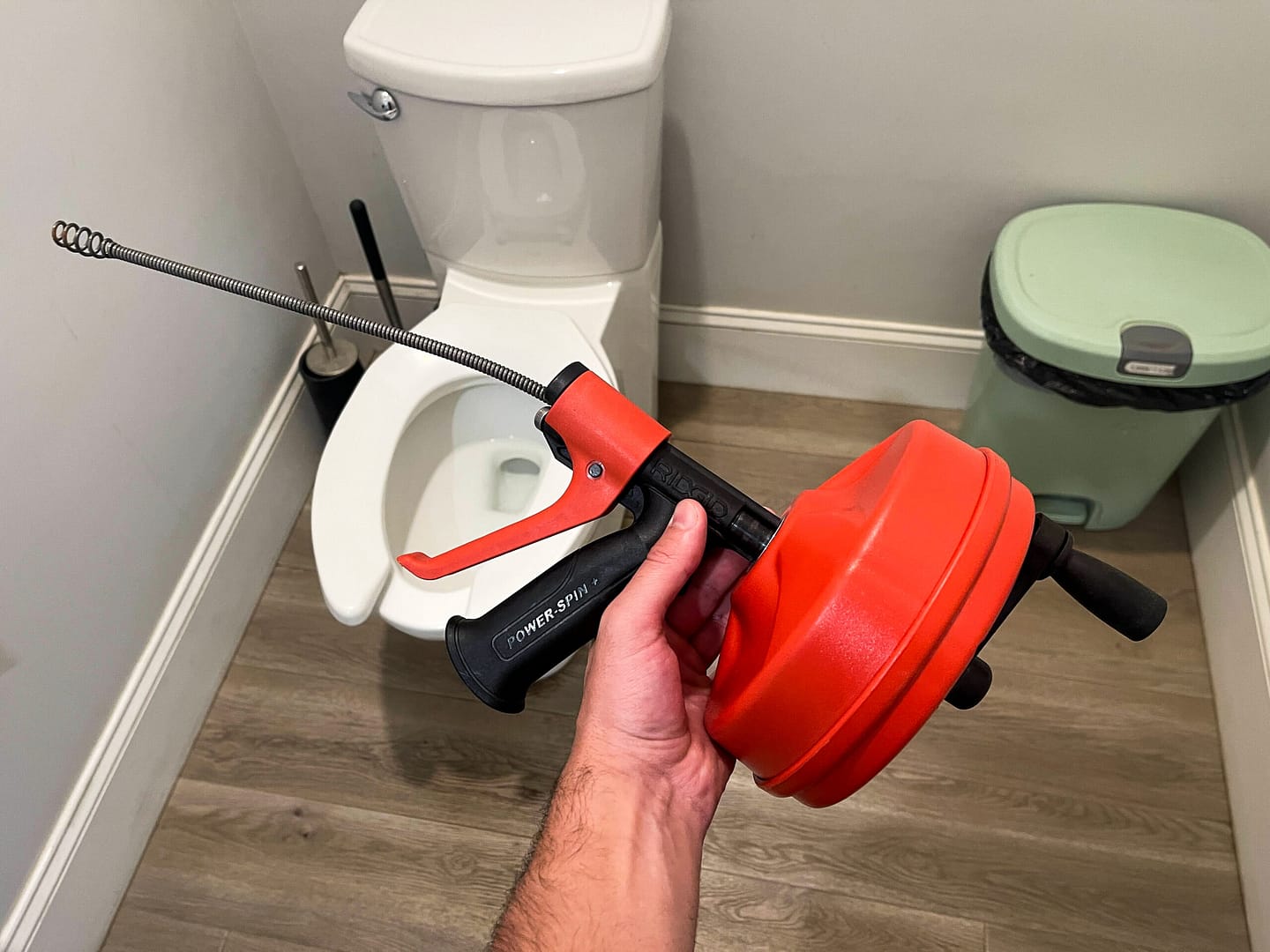If you’re searching for “how to unblock a drain” it’s likely you’re wondering what exactly a plumbing snake is. They go by a few different names; plumbers snake, augur snake, pipe cleaning tool and various mutations on this theme. Whatever they’re called, they’re a simple way of removing blockages from pipes.
What Is A Plumbing Snake?
A plumbing snake is a simple tool used for unblocking pipes. There are different versions of them for different tasks but they all have the same basic features:
- A long, flexible coil
- A handle that allows them to turn
They’re generally made of thin metal. This gives them a good level of flexibility, allowing them to work their way along your pipes. If a clog is too big to be dislodged by a plunger, a snake is probably your best bet.
There are endless variations on the theme, but the most commonly used in a residential setting are manual and motorized snakes and toilet augers.
How Does A Plumbing Snake Work?
Put simply, you push the coil of the snake down your clogged pipe until you meet resistance then start to twist. The coil allows you to bore into whatever is blocking your pipe, hooking on to it or drilling through. You can then pull out the offending items or allow the force of water to clear the rest.
Manual Plumbing Snakes
If you’re using a manual plumbers snake, the handle should allow you to turn the tool. Hold it in one hand and twist with the other. This rotary motion turns the coil, allowing the end to work its way in to whatever is blocking your pipe.
Motorized Plumbing Snakes
Alternatively, if twisting by hand seems like too much effort, a motorized model will do the work for you. They certainly make the process quicker and less laborious, but have the downside of requiring a power source. In many bathrooms (which account for most blocked drains), this can present a problem. They can also potentially lead to damaged pipes if not used carefully.
Toilet Augur Cleaning Tools
A toilet augur on the other hand will look a little different. Because we generally don’t want to pull whatever is clogging your toilet back up, the coil will end in something resembling a drill head. They’re still flexible enough to allow you access deep within the drain, but they aim to create a pathway through the blockage, breaking it up rather than fishing it out.
It’s also worth noting that, thanks to their flexible design and boring action, snake cleaning tools are most useful in dealing with certain types of clogs. Fibrous materials like hair, grease and small objects lodged in a pipe are fairly easy to deal with as they provide something for the coil to grip as it works its way through.
When Should You Use A Plumbing Snake?
As we said above, plumbing snakes are ideal for dealing with certain types of clogs. They need something that they can get lodged into the twists of the coil or work their way through. This makes them ideal for dealing with common problems like hair, soap scum and grease, but unsuitable for more solid blockages.
They’re generally better employed when facing a deep blockage, slow draining or a relatively minor clog. For more serious issues, a plunger or chemical drain unblocker might serve you better, breaking up the blockage. It’s all about using the correct tools for the job.
Under most circumstances, snaking a drain can be done on a DIY basis. You can pick up an augur or plumbers snake at any hardware store. On occasion, it might be worth getting the pros in. This applies if:
- The Clog is Particularly Deep: The deeper the clog, the more potential for damage to pipes. Plumbers might use something like a sectional cable machine to reach deeper into your pipes than is feasible for a DIY job.
- The Clog is Particularly Severe: Professional options such as water jet augurs may be needed.
Step By Step Guide To Using A Plumbing Snake
Now we know what a drain snake is and when it’s best employed, how do you go about actually using it? Follow this simple step-by-step and your drains should be clear in no time.
- First, work out roughly where the clog is and how bad it might be. This should allow you to decide which augur cleaning tool is best for the task at hand, or if you need to phone a plumber.
- Gather together your tools. You’ll need your plumbers snake, gloves and a bucket.
- Uncoil your snake. Push it gently down the drain. If the blockage is either in or beyond a P-trap, try removing it first. This will either allow you to flush it out or at least give easier access.
- Maneuver your plumbers snake through the pipe. Work slowly, pushing gently from the top. Pushing too hard may end up damaging your tool or pipework. You can feed the coil down but it’s better to rotate the handle.
- Stop when you feel resistance. This is likely your clog. Wiggle the snake. This will start to break up the blockage. Alternatively, keep slowly rotating to allow the augur to work its way in.
- Pull out. Your snake may have hair, grease and other assorted drain gunk on it. If so, you’re making progress.
- Test your drain to see if the obstruction has been cleared. Flush it through with more water and see if it drains properly.
- If not, repeat the process.
If you find that repeated snaking isn’t sorting your issue, call a plumber.
After you’ve unblocked your drain, make sure that you clean your tool properly. The contents of clogs can be pretty unpleasant and filled with bacteria. Whatever was blocking your pipe is probably not something you want in your toolbox.
Common Mistakes
Even with such an apparently simple tool, mistakes can happen, causing damage and leaving the job unfinished. Snake cleaning tools are generally pretty simple things to use, but getting it wrong does have consequences. Firstly, there’s nothing more frustrating than setting out to do a job and finding it’s not possible. Wasting time with the wrong tools will ruin anyone’s day. Secondly, and more importantly, there’s always a small risk of damaging your plumbing further.
The most common error that people make is selecting the wrong tool for the job. A snake which isn’t long enough or flexible enough won’t clear your drain. Likewise, a thin drain snake won’t do the job of a toilet augur. Taking stock of the situation and selecting the right implements before getting started will make the process much easier.
If you’re not careful, a badly used snake or augur could scrape or damage your drains. Make sure you’re keeping the pressure and angle just right to avoid this and go slowly. If you feel scraping, stop and readjust the tool. If you feel pressure, don’t be tempted to try and force it through. Let the snake do its job. While plumber’s snakes are flexible, they’re still made of metal and will scratch or bore through plastic if not used carefully.
It’s important to avoid using excessive force as it will make the tool much less effective. Turn the handle slowly and push gently to avoid damaging pipes or kinking your drain snake. Simply shoving them down the plughole and hoping for the best may make them flex back on themselves. If this happens, a loop will be pushed against your clog rather than the augur head. The result is a lot of wasted effort and a drain that’s still blocked.
Of course, the best advice for any keen DIY plumber is this: know when you’re beaten. While most clogs can be fairly easily dealt with a little knowhow, sometimes they need a pro. Particularly stubborn blockages or ones which are out of reach will require a professional plumber and their specialized toolkit.

